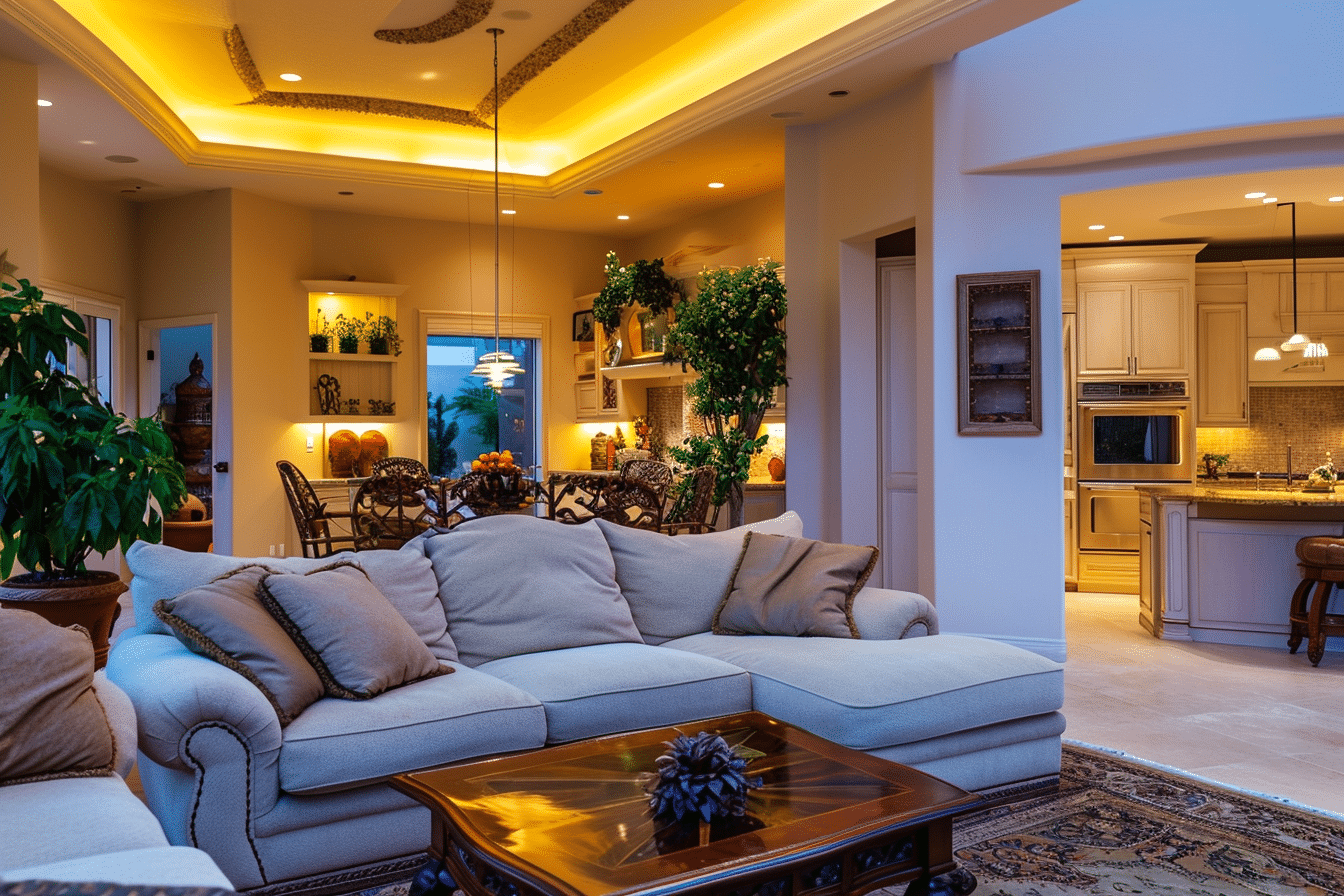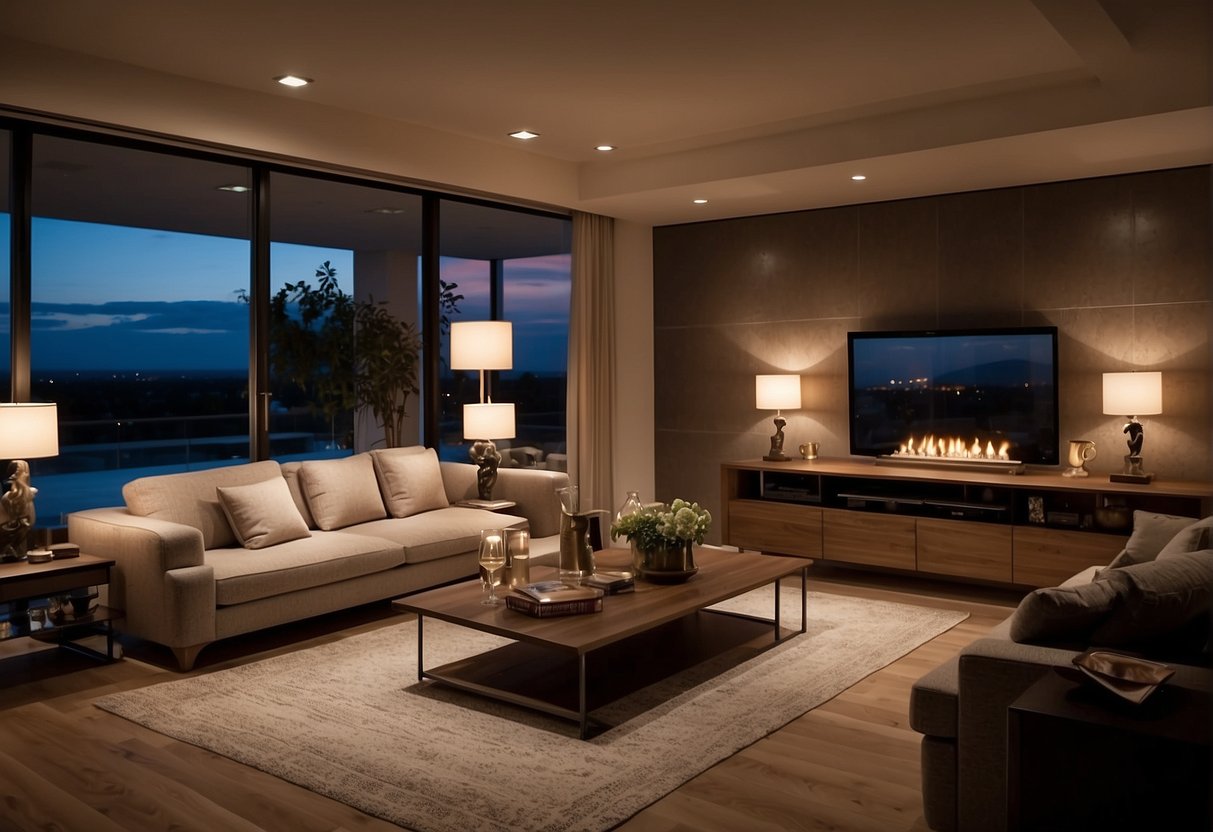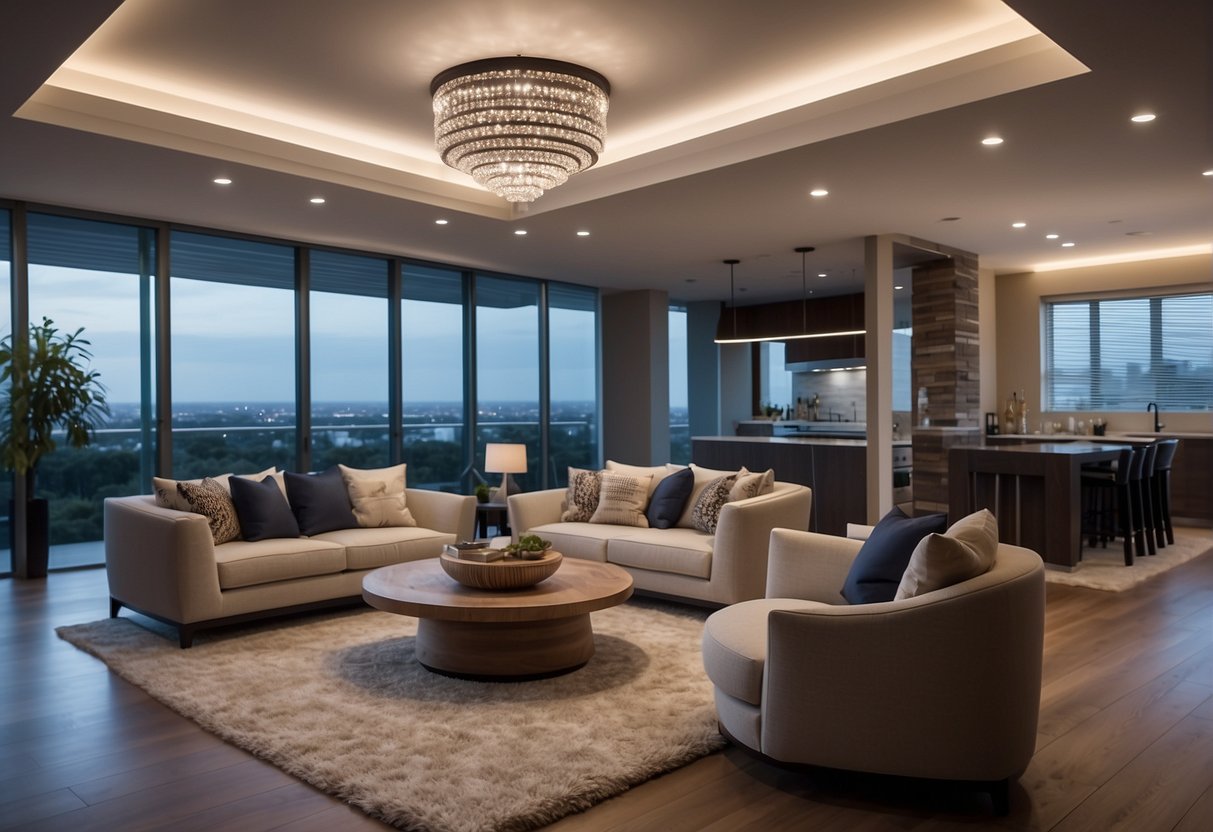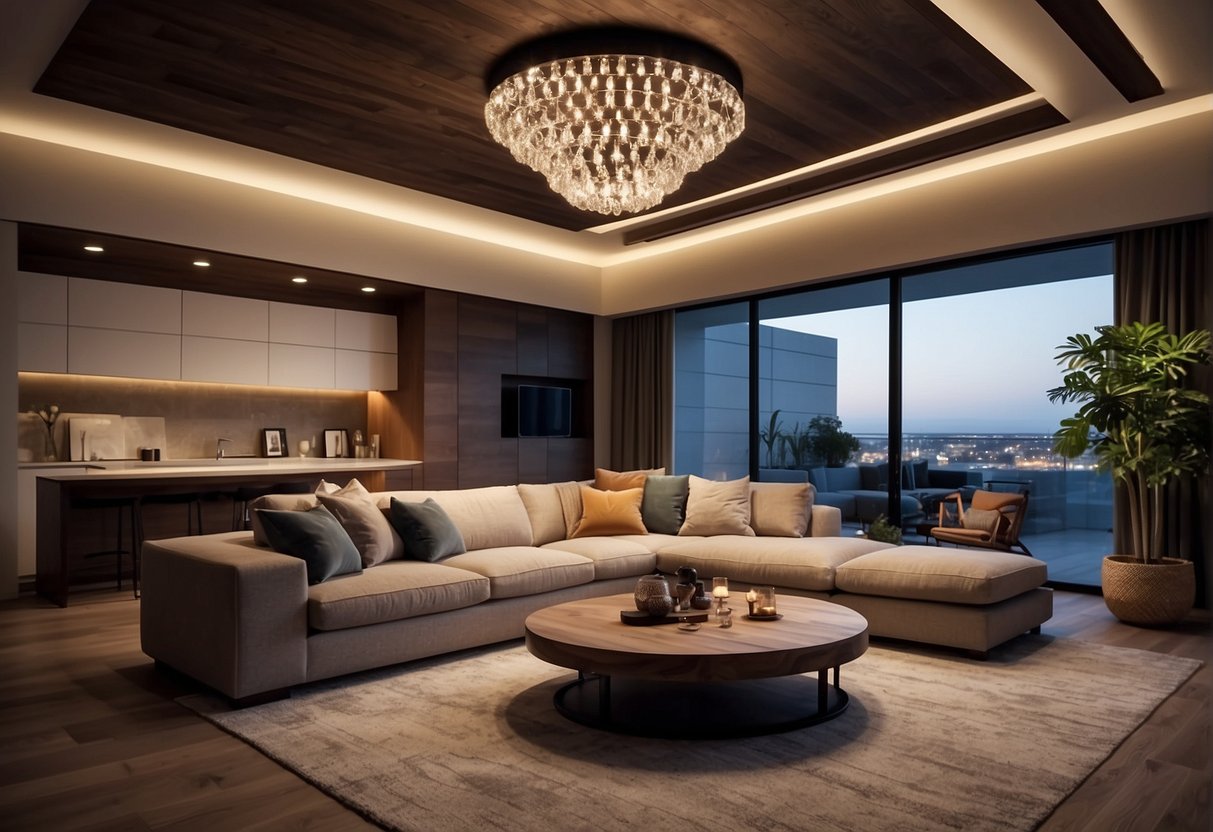
Layered Lighting in Home Staging
Layered lighting is an essential element of successful home staging, as it creates a welcoming atmosphere that not only enhances the home’s aesthetic appeal but also influences the prospective buyer’s mood. This technique combines various types of lighting, such as ambient, task, and accent lighting, to create depth, dimension, and functionality within a room. As a result, it helps to showcase a property’s best features by directing attention to key focal points while ensuring a comfortable and inviting environment for potential buyers.
Home staging experts understand the importance of a well-designed lighting plan in bringing out the best in a space and making it attractive to potential buyers. Strategic lighting placement in different areas of the home, combined with the right choice of fixtures and technical aspects of illumination, can significantly impact the overall impression of a property on the market. By employing layered lighting, sellers can effectively highlight the desirable characteristics of their home and create an emotional connection with prospective buyers.
Key Takeaways from Layered Lighting in Home Staging
- Layered lighting combines various types of lighting to create depth, dimension, and functionality within a room
- Strategic placement of lights and fixtures can significantly impact the overall impression of a property on the market
- Well-designed lighting plans help to showcase a home’s best features and create an inviting environment for potential buyers
The Basics of Layered Lighting
Layered lighting is an essential aspect of home staging, where different types of lighting are combined to create an inviting and functional space. In this section, we will discuss the three main layers of lighting: ambient, task, and accent lighting, as well as the importance of lighting in home staging.
Understanding Ambient, Task, and Accent Lighting
Ambient lighting is the primary layer, providing general illumination for an entire room. This can be achieved using fixtures such as ceiling lights, chandeliers, or wall-mounted lights. Its purpose is to create a comfortable level of brightness in the living space without causing glare or eyestrain.
Task lighting focuses on specific areas where increased lighting is required for activities like reading, working, or cooking. Examples of task lighting include desk lamps, reading lamps, and under-cabinet lights in the kitchen. These lights help to improve visibility and reduce eye strain while performing tasks that require close attention.
Accent lighting highlights particular features or adds drama to a room, such as artwork, architectural details, or collectibles. This layer is often used in home staging to draw attention to appealing aspects of a property, using wall sconces, picture lights, or spotlights.
By combining these three layers of lighting, you can create versatile and attractive living spaces as illustrated in A Beginner’s Guide to Lighting in Layers.
Importance of Lighting in Home Staging
In the context of home staging, effective lighting can significantly impact how potential buyers perceive a property. Properly staged lighting can:
- Set the mood: Warm, cozy lighting can make a room feel more inviting, while cool, bright lighting can accentuate a clean, modern aesthetic.
- Highlight features: Accent lighting can draw attention to unique architectural details or impressive artwork, positively impacting the buyer’s impression of the property.
- Improve functionality: Task lighting ensures adequate lighting for various activities and adds comfort and usability to space.
- Enhance spaciousness: Adequate ambient and task lighting can make the room feel larger and more open, especially in areas that might otherwise appear dark and cramped.
In conclusion, implementing layered lighting is an essential aspect of successful home staging. A well-thought-out lighting plan can significantly enhance a property’s visual appeal and functionality, making it more attractive to potential buyers.
Designing with Light for Home Staging
Creating a Welcoming Atmosphere
The first step in designing with light for home staging is to create a welcoming atmosphere. To achieve this, it’s essential to incorporate layered lighting into your home. This includes a mix of task, general, and mood lighting that can truly make your home a masterpiece1. Start by focusing on the entryway, where soft, ambient light should greet visitors and set a warm, inviting tone.
Enhancing Architectural Features
Next, it’s important to enhance architectural features in your home using lighting design. Accent lighting can highlight unique elements, such as built-in bookcases, fireplaces, or coffered ceilings. You can use options such as recessed spotlights, wall sconces, or LED strip lights to emphasize these features and draw attention to the special details of the space. By doing so, you show off your home’s best assets and make them stand out to potential buyers.
Setting the Mood with Color Temperature
Another crucial aspect of staging a home with light is setting the mood with color temperature. Color temperature can enhance the atmosphere, making it either warmer or cooler with various shades of white light. Choosing the right color temperature for different rooms can affect the mood, with warmer tones being more relaxing and cooler tones promoting focus and energy2.
| Room | Color Temperature |
|---|---|
| Living Room | 2700K-3000K |
| Bedroom | 2700K-3000K |
| Kitchen | 3500K-4100K |
| Home Office | 4100K-5000K |
In conclusion, designing with light for home staging involves creating a welcoming atmosphere, enhancing architectural features, and setting the mood with color temperature. With the right balance of each, you can effectively draw potential buyers in and make them feel at home.
Footnotes
-
For practical examples of color temperature, consult CNET’s guide on how to choose the right LED light bulb. ↩
Strategic Lighting for Various Home Areas

Living Room Lighting Concepts
When designing the lighting layout for your living room, keep in mind the importance of layered lighting. Ambient, task, and accent lights work together to create a balanced and functional space. Start with ambient lighting such as floor lamps or chandeliers to establish the overall tone. Next, add task lighting like table lamps for activities like reading. Lastly, include accent lighting to highlight artwork, plants, or other decor elements.
Kitchen Lighting Solutions
The kitchen demands a combination of lights to properly illuminate the workspace. Ambient lighting from overhead fixtures sets the foundation, while task lighting ensures safety and enhanced visibility when preparing meals. Consider under-cabinet LED strips or pendants above island counters as task lighting options. Accent lighting, such as inside glass-front cabinets, adds character and depth to the space.
Bedroom Lighting Ideas
A well-lit bedroom enhances relaxation and promotes a good night’s sleep. Begin with soft and soothing ambient lighting from floor lamps or wall sconces. Task lighting is essential for reading and working, so consider adding bedside table lamps or adjustable wall-mounted lights. Lastly, incorporate accent lighting to showcase artwork or architectural features like a fireplace or dramatic bed frame.
Bathroom Lighting Tips
Properly lighting a bathroom can transform it into a personal sanctuary. Start with ambient lighting from recessed ceiling fixtures and supplement with task lighting around the mirror to prevent shadows when grooming. Sconces, vanity lights, or even LED strips can be utilized for this purpose. Finally, accent lighting can spotlight artwork or create a relaxing atmosphere with dimmable lights near a bathtub or shower.
Choosing the Right Light Fixtures

Types of Light Fixtures and Their Uses
When it comes to selecting light fixtures, there are several options to consider. Each type of fixture serves a specific purpose, and knowing the function of each can help you make the best choice for your home staging. Here are some popular light fixtures and their uses:
- Lamps: Table and floor lamps provide indirect, ambient light that can be used to soften the appearance of a room or highlight certain features. They can be easily moved, making them a versatile option.
- Pendant lights: These hang from the ceiling by a cord or chain, and are often used as task or accent lighting above kitchen islands or dining tables.
- Wall sconces: Mounted to the wall, these light fixtures are often used for accent lighting or to illuminate hallways and staircases.
- Chandeliers: A chandelier serves as a decorative centerpiece and provides ambient lighting in larger rooms, such as formal dining rooms or foyers.
The Role of Natural Light
Natural light plays a significant role in home staging. By letting in sunlight through windows, skylights, and sliding glass doors, you can create an inviting atmosphere with a warm, natural glow. When staging your home, consider how to maximize natural light:
- Opt for light, sheer curtains that allow sunlight to filter through.
- Remove obstructions from windows to let in as much light as possible.
- Use mirrors to reflect natural light and make a room appear larger and brighter.
Electric Lighting Options
In addition to natural light, electric lighting is essential for creating a well-lit and welcoming environment. Here are some electric lighting options to consider when choosing light fixtures for your home staging:
- LED bulbs: These energy-efficient bulbs use less electricity and produce less heat than traditional incandescent bulbs. They are available in various color temperatures, allowing you to create the desired ambiance.
- Smart bulbs: These are a popular option for modern homes, as they allow for easy control of lighting settings and color on your smartphone or with a voice assistant.
- Dimmer switches: Installing dimmer switches can give you more control over the brightness and mood of a room, allowing you to adjust the lighting as needed.
By considering the different types of light fixtures, the role of natural light, and the various electric lighting options, you can choose the ideal lighting for your home staging to create a cozy, welcoming atmosphere for potential buyers.
Technical Aspects of Home Lighting

Understanding Lumens, Kelvins, and Watts
When considering lighting for home staging, it’s essential to understand the lumens, kelvins, and watts. Lumens measure the brightness of a light source, with higher lumens corresponding to a brighter light. Kelvins, on the other hand, indicate the color temperature of the light. Lower kelvin values represent a warm, yellowish light, while higher kelvin values correspond to a cool, bluish light. Lastly, watts measure the amount of energy consumed by the light source.
A quick breakdown:
- Lumens: Brightness of the light
- Kelvins: Color temperature (warm to cool)
- Watts: Energy consumption
Energy-Efficient Lighting Choices
Energy-efficient lighting options have become increasingly popular in recent years. Consider using one of the following energy-saving options when staging your home:
- LEDs (Light Emitting Diodes): These lights consume less energy, have a longer lifespan, and produce less heat compared to traditional incandescent bulbs.
- CFLs (Compact Fluorescent Lamps): While not as energy-efficient as LEDs, they still consume less energy and have a longer lifespan than incandescent bulbs.
| LEDs | CFLs | Incandescent | |
|---|---|---|---|
| Energy | Low | Medium | High |
| Heat | Low | Medium | High |
Lighting Controls and Dimmers
Incorporating lighting controls and dimmer switches gives you the flexibility to create various moods and scenes for your home. Lighting controls can be as simple as a traditional switch or as advanced as a home automation system. Dimmer switches are a popular choice for their ability to adjust the brightness of the lights, allowing you to set the ambiance for different occasions.
In summary, understanding lumens (brightness), kelvins (color temperature), and watts (energy consumption) will help you make informed decisions for your home lighting. Opt for energy-efficient lighting choices such as LEDs or CFLs. Lastly, take advantage of lighting controls and dimmer switches to create the perfect atmosphere for potential buyers.
Staging Tips for Selling Your Home

Maximizing Curb Appeal with Outdoor Lighting
Nothing grabs a potential buyer’s attention like great curb appeal. Well-designed outdoor lighting not only enhances the look of your home, but it can also make it safer and more inviting. Here are a few staging tips for outdoor lighting:
- Use solar-powered LED lights to line walkways and garden paths.
- Install a well-placed, attractive spotlight to highlight your home’s architectural features.
- Hang lanterns or string lights to create an inviting atmosphere for your patio or porch.
The Psychological Impact of Lighting on Potential Buyers
The right indoor lighting can affect how potential buyers perceive your home. Use these staging tips to create a welcoming ambiance:
- Swap out harsh fluorescent lights for softer LED bulbs.
- Utilize dimmer switches to control the intensity of light.
- Play with layered and ambient lighting to create depth and warmth.
| Room | Ideal Lighting |
|---|---|
| Living Room | Soft, warm glow |
| Kitchen | Bright, task lighting |
| Bedroom | Cozy, ambient lighting |
Final Touches: Floor and Table Lamps
In addition to built-in lighting fixtures, floor and table lamps can add personality to your home. They serve as functional decor pieces that brighten dark corners and make rooms feel more spacious. Consider these simple tips when using lamps in your staging:
Opt for neutral shades that complement your existing decor, rather than bold patterns or colors.
Choose lamps with adjustable brightness to cater to various potential buyers’ preferences.
Arrange lamps thoughtfully throughout the space, ensuring they don’t obstruct walkways or overpower furniture.
Luxury Specialist at McGraw Realtors
With a diverse background, including a career as an Air Force fighter pilot and entrepreneurship, Bill transitioned to real estate in 1995. Co-founding Paradigm Realty with his wife, Charlene, he quickly rose to prominence in Oklahoma City’s luxury real estate scene. Now, as one of the top agents with annual sales surpassing $20 million, Bill’s dedication to exceptional service remains unparalleled. With a legacy spanning over two decades in the industry, Bill’s expertise and commitment make him a trusted name in luxury real estate.